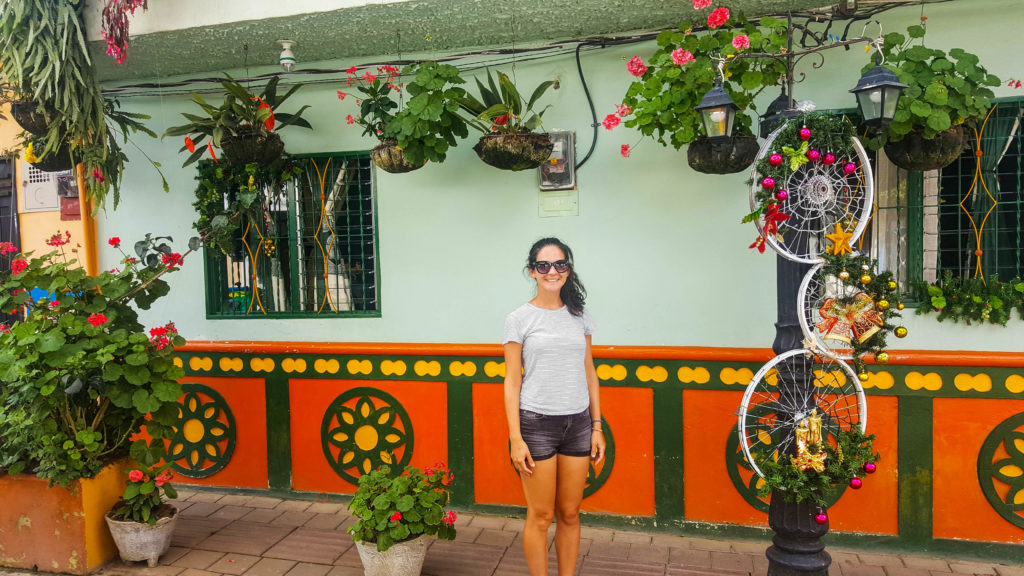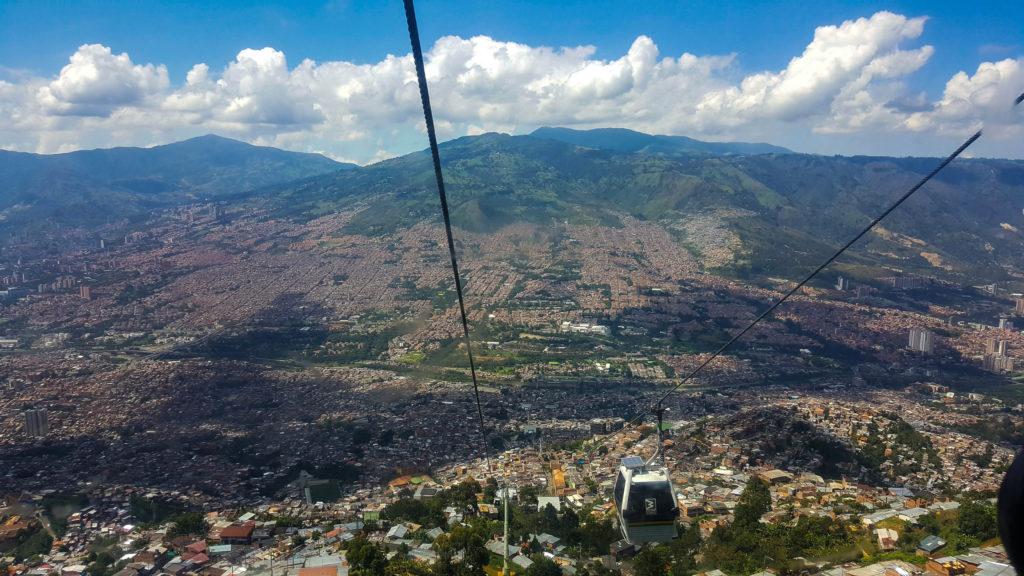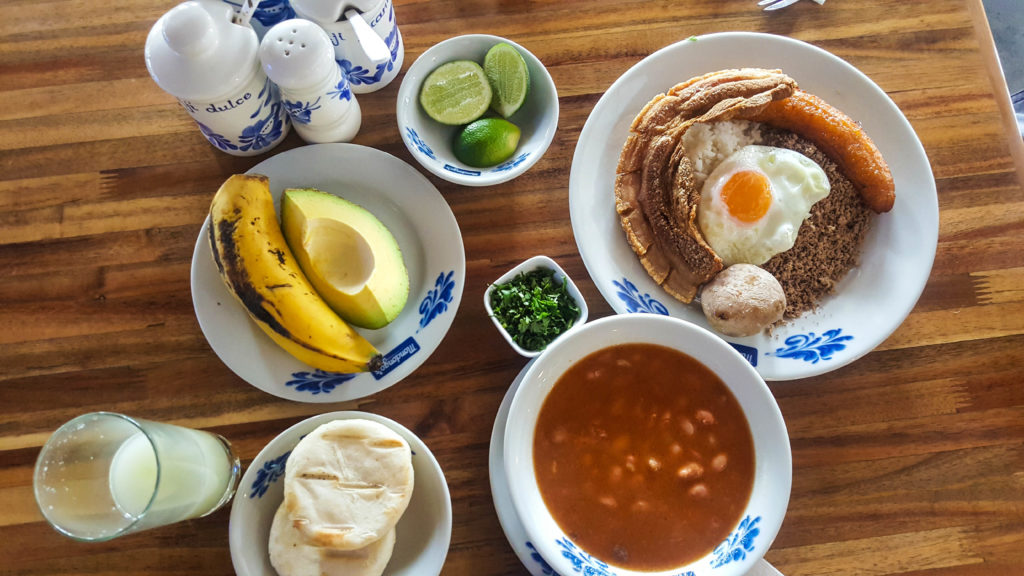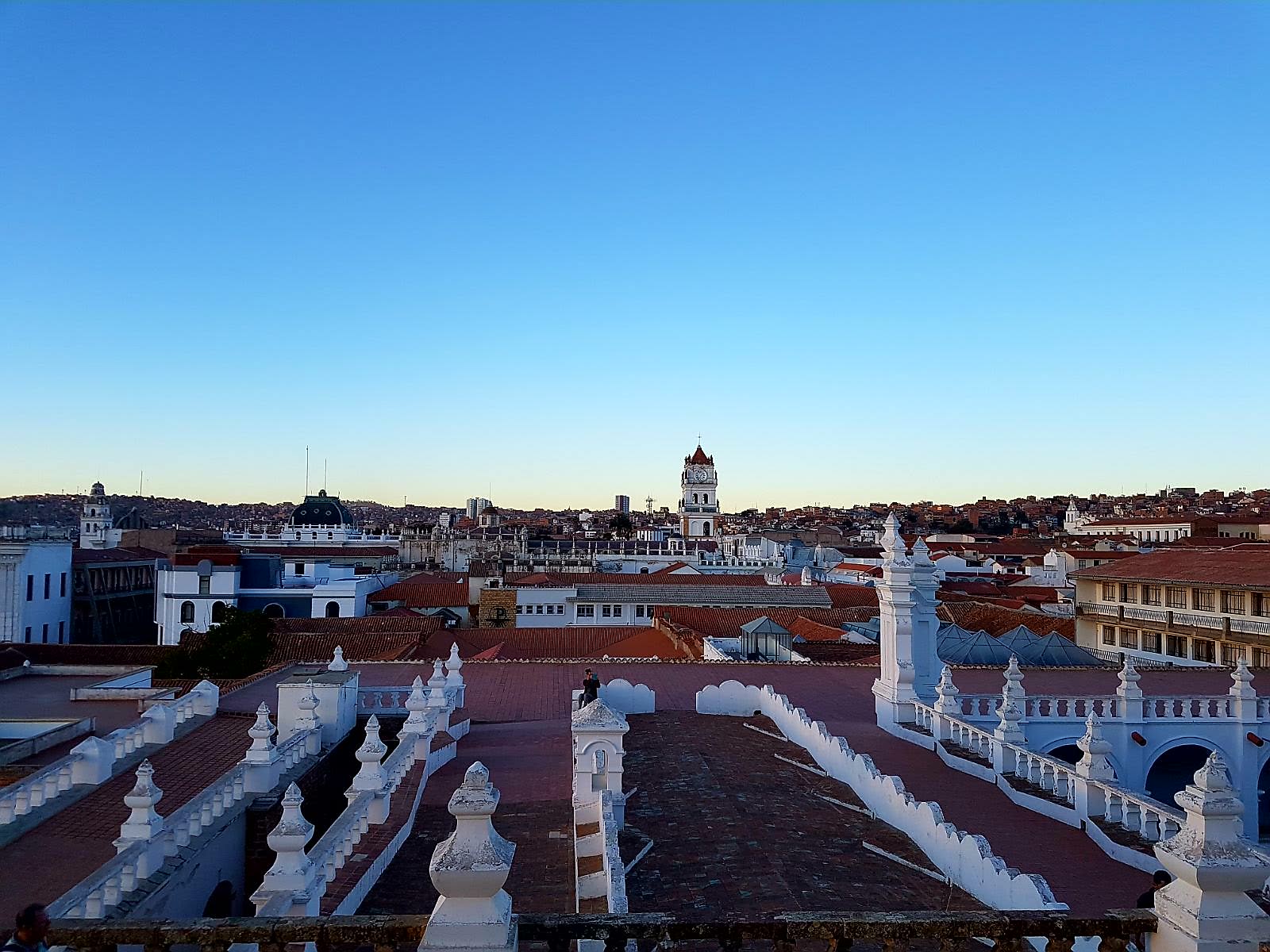We love cities and after great reviews from other travellers we couldn’t wait to visit Medellín, Colombia’s second largest city. Once labelled the world’s most dangerous city, Medellín is now an innovative, creative and vibrant place with plenty to keep visitors busy. We spent 10 days here, easily filling our days with Spanish lessons, museums, walking tours and day trips.
Things to do / see
1. Go on a Day Trip to Guatape
Guatape is a small town, about two hours drive from Medellín, famous for its zocalo art and the nearby Piedra del Penol (the Stone of El Penol) or simply La Piedra (the Rock).
Like most tourists, we decided to visit Guatape as a day trip. Getting to Guatape couldn’t be easier with local buses leaving Medellín’s Terminal Norte every hour. Tours are also available but didn’t seem to be worthwhile given the ease and great value of using public transport.
La Piedra is on the way to Guatape, so we chose to visit the Rock first. Climbing the 740 steps to the top was not too strenuous but as the Rock is popular with both domestic and foreign tourists the walk is busy, as is the viewing platform at the top. The views are beautiful though! Interestingly, what appears to be a lake dotted with tiny islands is in fact a hydro-electric dam powering about 30 per cent of Colombia.


To get to Guatape you just flag one of the buses from the same spot where you got dropped off. The town is about 10-15 minutes drive from the Rock and is located on the banks of the man-made lake. On the Sunday when we visited most of the activity seemed to be on concentrated on or around the water. Little stalls selling food were set up on the footpath, boats full of passengers were pulling in or going out for rides and families were having picnics on the grassy bank. People watching seemed to be the main source of entertainment with groups gathered at the end point of a nearby zipline cheering and laughing at the zipliners as they came in. A bit further down the lake we came across what look like a giant inflatable castle at first but then realised it was a people launcher. One person waits at the bottom while another jumps off a spring board to launch them into the water. This looked amazingly fun and one to try if you have swimwear/a change of clothes with you – unfortunately we didn’t.
Cross the road and walk up from the lake and you will find yourself in one of the most colourful towns we’ve ever seen. Not only is each house painted a different colour but the buildings are all decorated with little pictures, known as zócalo art. The little town is perfect to wander around for an hour or so taking photos, and then grabbing a drink or lunch in one of its many restaurants or cafes.


To get back to Medellín there are hourly buses but they get busy so it is best to pre-book your ticket for your preferred return time when you arrive in Guatape. There is a small ticket office right where the buses stop.
2. Take Spanish Lessons
Medellín has a number of Spanish schools and quite a few people we met took lessons here. With our Spanish not progressing as well as we would have liked, we decided to take a few more lessons as a refresher.
We ended up going with Toucan Language School as it was the closest to our hostel. I know it is unfair to compare but the experience was no where near as good as the one we had in Bolivia. Our teacher was young and bubbly and we had fun in our lessons but she was no where near as experienced or able to explain as well as Tatiana (our teacher in Sucre). The school was modern with friendly staff but lacked the charm of our school in Sucre. There were activities organised in the afternoon and we did attend a mixer where the aim was for us to practice our Spanish and the locals their English but we didn’t like it. It somehow just felt forced.
All up we had 10 hours of private lessons which did give us a chance to refresh some of what we had already learnt and pick up a few new things – although sadly most already probably forgotten. Having the lessons in the afternoon (4-6pm) also meant that we had the mornings to explore. All in all, I’m glad we did the classes but if I were to have our time again I would choose a different school.
3. Do a Walking Tour with Real City Tours
This is one of the most popular things to do in Medellín and advance booking is required. The tour groups are quite large so it is not an intimate experience but we thought that it was definitely worth doing. The tour gave us a greater understanding of the city, its people and Colombia in general.
The tour lasts about four hours and takes you through the centre of Medellín and some areas you may not visit by yourself (and is probably not a good idea to visit on your own after dark). During the tour our guide was very open – we talked about politics and the very new and fragile peace with the FARC group. Our guide also told us about what his family had been through and their willingness to move forward for the sake of peace.


During the tour we walked through some beautiful plazas and tried some local food, including Colombia’s version of buñuelos (cheese balls) which are particular popular at Christmas. The tour ended at Parque San Antonio where in 1995 a bomb was place in a Botero statue and detonated during a concert killing over 20 people.
It is clear that Medellín has a dark history and unfortunately there is still a stigma attached to visiting Colombia. But what also became clear to us during the tour was how much Colombia is trying to move on from the past and shake its negative image. As tourists, we felt very welcome and were thanked a number of times by our tour guides for visiting their city.
4. Take a Cable Car to Park Arvi
The metro cable was designed as a means of local transport to reach and connect some of the communities residing up in the steep hills above the city. Starting its operation in 2004, it was the first such system in Latin America with other cities since implementing similar modes of transportation.
The metro cable has a number of lines but the ones most tourists tend to use are those connecting you to Parque Arvi, a huge natural reserve. The park has a number of walking and biking trails but as we discovered on arrival most of them require a guide. We did eventually stumble on a short walking trail which we could do but did find the overall experience a bit confusing especially as there was little information and little English spoken.
While the walk was nice, the best part for us was the cable cars ride and the amazing city views.

5. Ride the Escalators and appreciate the Street Art at Communa 13
San Javier, also known as Communa 13, is a neighbourhood in the hills of Medellín. Due to its strategic location, on the drug/arms smuggling route, between the late 1990s and early 2000s Communa 13 was one of the most dangerous neighbourhoods in Medellín. The area however has seen amazing transformation over the past eight or so years largely thanks to outdoor escalators completed in 2011 (and connecting the area to the rest of the city), amazing street art and community spirit.
These days it is safe for tourists to explore the neighbourhood. You can visit on your own but there are also a number of tours which can enhance your experience. We chose to go with Stairway Storytellers which is run by a group of residents of Communa 13.


Lucky for us, but not so lucky for our guide, this ended up being a private tour for just the two of us. The other people who booked and were meant to join never turned up! Our guide (whose name I really should remember!) was only 18 years old and seemed to know everyone we passed. During the tour we learnt about the violent history of the area, a time when it was common for children to see bodies on the street on the way to school, and also saw some amazing street art with our guide explaining the significance of the pieces and telling us a bit about the artists.
In its attempt to ‘clean up’ the area, the government launched a controversial military operation in the neighbourhood in 2002, called ‘Operation Orion‘. The operation was over a number of days during which time many innocent people were killed and many people disappeared without a trace. As part of the operation a right-winged paramilitary group entered the neighbourhood taking control over the area. Whilst the homicide numbers dropped after the operation, people continue to disappear and many were displaced. A very sad and very recent history and but so amazing and inspiring to see and hear about the area’s transformation. The street art was also incredible! Without doubt, visiting Communa 13 was one of the highlights from our time in Medellín.


6. Visit Plaza Botero and Antioquia Museum
Located in the historical centre of Medellín, the plaza and the museum are worth a visit to see a some of Fernando Botero’s works. Botero, who was born in Medellín, is famous for his paintings and statues depicting people and animals in plus-size. We really liked the art, to us especially the colourful paintings, felt like fun and happy art. (Note: you do visit Plaza Botero as part of the walking tour but not the museum).


7. Learn More about Colombia’s Past at Casa de la Memoria
This is a small but powerful museum in memory of the victims of Colombia’s violent conflicts. Unfortunately, most of the information was in Spanish and some sections of the museum were closed so we didn’t get out as much out of our visit as we had hoped but it was still interesting.
The museum included a display allowing you to see the numbers of homicides and kidnappings by area and by year, the numbers are absolutely staggering and all too recent. Sadly, many people still don’t know what happened to their loved ones.
8. Explore El Polado
El Poblado is an upscale neighbourhood with many bars, restaurants and cafes. It is also where most of the hotels and the hostels are located. As a result this is where most of the gringos (non Latin Americans) end up staying and spending a lot of their time while in Medellín, hence earning the area the nickname Gringolandia.
The neighbourhood is safe, modern, with pretty tree lined streets. Carrera 35 and Carrera 37 are particularly nice to explore as both streets are full of cute little boutiques, inviting cafes and chic looking restaurants.
9. Enjoy Medellin’s Chrismas lights (if visiting in December)
Medellín is famous for its Christmas light displays so if you happen to visit the city in December you are in for a nice treat. During our visit the city was celebrating the 50 year anniversary of its light displays so had more lights on show than ever. We didn’t go out of our way to see the lights but there were plenty of decorations around El Poblado, in particular at and around Parque Lleras.

10. And You Can do Much More
There are many other things and activities to do in and around Medellín. You can take salsa lessons, wander around the Botanical Gardens or visit the Museum of Modern Arts. Another area worth visiting is Santo Domingo Savio or Communa 1, again once a dangerous neighbourhood controlled by drug cartels the area has undergone a transformation and is home to the impressive Biblioteca de Espana. You can visit the neighbourhood on the way to or from Parque Arvi, as the metro cable to the park goes from Santo Domingo.
There are also various Pablo Escobar themed tours but we steered clear of these. To us it just didn’t feel right to go tours which may glorify one of the darkest people in Colombia’s history or from which some of his past associates may profit. We chose to learn about Colombia’s history through other tours and our own reading.
Eating and Drinking
Medellin and especially El Poblado have plenty of restaurants, bars and cafes. These are a few that we got to during our stay:
- Hija Mia – our favourite coffee place in Medellín in Barrio Manila (not far from El Poblado). Friendly Kiwi owner and excellent coffee.
- Pergamino Cafe – although we had every intention of visiting this popular cafe we just never got there. A bit of a fail.
- Cafe Velvet – pretty much across the road from Pergamino, we went to this cafe for lunch and coffee. The menu del día was OK but nothing special, the same for the coffee.
- Cafe Zorba – awesome vegetarian/vegan only pizzas, a buzzy vibe and wine by the glass. This was our favourite place.
- El Zorro y la Gitana – another great little pizza place.
- Halong Vietnamita – we were excited to have this Vietnamese restaurant a few minutes walk from our hostel. The first dinner we had there was awesome but lunch a few days later was disappointing. A good place if you’re craving some Asian food in Latin America but don’t expect anything mind blowing.
- El Social – a busy bar in the centre of El Poblado with outside seating and a fun atmosphere. When we went the bar was full of trendy locals ordering spirits by the bottle.
- Parque Lineal Ciudad del Rio – this area is home to Medellin’s food trucks. The best time to visit is Friday to Sunday night. We thought the food trucks were great and had some delicious arepas and pizza but the area didn’t have much of a vibe.
- Bandeja Paisa – not a restaurant but rather a traditional dish of the Antioquia region where Medellín is located. The meal consists of a mix of white rice, red beans, ground meat, chicharron (pork rind), fried egg, plantain, morcilla (black pudding), arepa, avocado and lemon juice – a bit of a heart attack! We shared a variation of this dish at Mondong’s, whilst it was not our favourite it is definitely one to try if you’re a meat eater.
- Aguardiente – again not a restaurant but rather a Colombian spirit. Available all over Colombia but we tried it in Medellín. It’s an anise flavoured liqueur made from sugar cane making it a good alternative for sambuca lovers. For us us one shot was enough!

Where to Stay
Most foreigners stay in El Poblado, and as already mentioned most hotels and hostels are in this area. Although the neighbourhood is full of tourists it is definitely a great spot to base yourself, especially as a first time visitor.
We stayed at El Alternativo, a cute little hostel in Manila. A short stroll from all the action of El Poblado, the hostel was in a lovely peaceful residential spot. Conveniently, it was also only a 5-10 minutes walk to the El Poblado metro station.
The hostel was simple but had a lovely roof terrace and a decent breakfast.
Getting Around
Medellín boasts the only underground system in Colombia which is the pride and joy of locals. The underground is clean, cheap and safe and was our main mode of transport during our stay. Uber is available and is a good option for late evenings/night time.





Luke
Good to see the blog is up and running again!
jennyval82
Thanks Wiltz! It was definitely overdue!